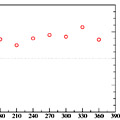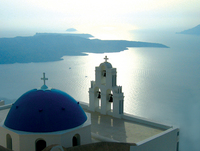Astronomy Picture of the Day
2012 April 8
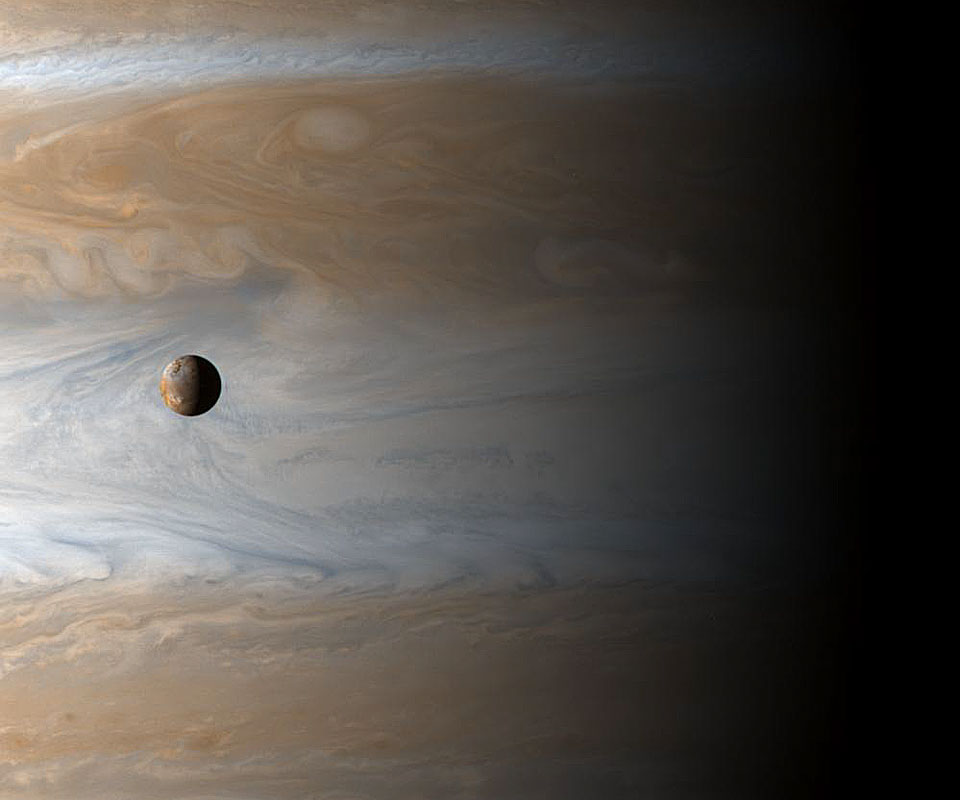 Io: Moon Over Jupiter
Io: Moon Over Jupiter
Image Credit: Cassini Imaging Team, SSI, JPL, ESA, NASA
2012 April 2
 Tungurahua Erupts
Tungurahua Erupts
Image Credit & Copyright: Patrick TaschlerExplanation: Volcano Tungurahua sometimes erupts spectacularly.
Pictured above, molten rock so hot it glows visibly pours down the sides of the 5,000-meter high
Tungurahua, while a cloud of
dark ash is seen being ejected toward the left. Wispy white clouds flow around the
lava-lit peak, while a star-lit sky shines in the distance. The above image was
captured in 2006 as ash fell around the adventurous photographer. Located in
Ecuador,
Tungurahua has become active roughly every 90 years for the last 1,300 years.
2012 March 31
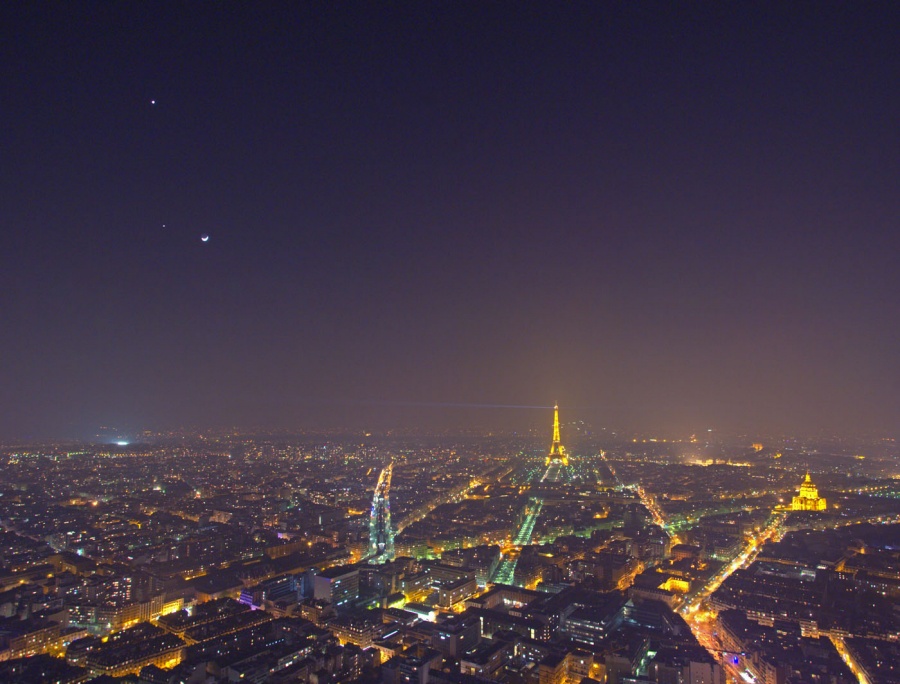 Paris by Night
Paris by Night
Image Credit & Copyright: Serge Brunier (TWAN)Explanation: Do you recognize the lights of Paris in this picture? In the cityscape taken on March 25 from the top of the 210 meter tall Montparnasse skyscraper, many will spot the looming
Eiffel Tower, or the large domed structure of Les Invalides (right), or the colorfully lit elevated Metro train line gently curving toward picture center. You can even pick out the Arc de Triomphe close to the horizon on the right. But regardless of your location, the celestial lights near the western horizon should look very familiar. The lovely triple conjuntion of brilliant Venus (top), Jupiter, and a young crescent Moon was visible in evening skies around planet Earth.
2012 March 28
 Earthshine and Venus Over Sierra de Guadarrama
Earthshine and Venus Over Sierra de Guadarrama
Image Credit: Daniel Fernández (DANIKXT)Explanation: What just above that ridge? The Moon. Specifically, the Earth's Moon was caught just above the horizon in a young crescent phase. The familiar Moon might look a bit odd as the exposure shows significant Earthshine -- the illumination of the part of the Moon hidden from direct sunlight by the sun-reflecting Earth. Also captured in the image is the bright planet Venus on the right. Venus and Jupiter passed only three degrees from each other last week during a photogenic
planetary conjunction. The above image was taken two days ago near Madrid, Spain. The foreground horizon silhouette includes some of the Seven Peaks of the Sierra de Guadarrama mountain range. Just a few minutes after this picture was taken, the Moon set.
2012 March 25
 Barred Spiral Galaxy NGC 1300
Barred Spiral Galaxy NGC 1300
Image Credit: Hubble Heritage Team, ESA, NASAExplanation: Big, beautiful, barred spiral galaxy
NGC 1300 lies some 70 million light-years away on the banks of the constellation Eridanus. This Hubble Space Telescope composite view of the gorgeous island universe is one of the
largest Hubble images ever made of a complete galaxy.
NGC 1300 spans over 100,000 light-years and the
Hubble image reveals striking details of the galaxy's dominant central bar and majestic spiral arms. In fact, on close inspection the nucleus of this classic barred spiral itself shows a remarkable region of
spiral structure about 3,000 light-years across. Unlike other
spiral galaxies, including our own Milky Way, NGC 1300 is not presently known to have a massive
central black hole.
2012 March 21
 Aurora Over Iceland
Aurora Over Iceland
Image Credit & Copyright: Daniel Lopez (El Cielo de Canarias)Explanation: If you see a sky like this -- photograph it. Three nights ago in Iceland, an adventurousphotographer (pictured) chanced across a sky full of aurora and did just that. Afterwards, by stitching together five smaller photographs, the entire aurora-lit sky was recreated in this 180-degree panorama taken fromVatnajökull glacier. Auroras are sparked by
energetic particles from the
Sun impacting the
magnetic environment around the Earth. Resultant energetic particles such as
electrons and
protons rain down near the Earth's poles and impact the air. The impacted air molecules obtain excited electrons, and when electrons in
oxygen molecules fall back to their ground state, they emit green light. Auroras are known to have manyshapes and colors.
2012 March 18
 Jupiter and Venus from Earth
Jupiter and Venus from Earth
Image Credit: Marek Nikodem (PPSAE)Explanation: It was visible around the world. The sunset conjunction of Jupiter and Venus was visible last week almost no matter where you lived on Earth. Anyone on the planet with a clear western horizon at sunset could see them. This week the two are still notable, even though Jupiter has sunk below the brighter Venus. And if you look higher in the sky you can see Mars as well. Pictured above, a creative photographer traveled away from the town lights of Szubin, Poland to image a near closest approach of the
two planets almost a week ago. The bright planets were separated only by three degrees and his daughter striking a humorous pose. A faint red sunset still glowed in the background. Although this conjunction is drawing to a close, another conjunction between Venus and Jupiter will occur next May.
2012 February 29
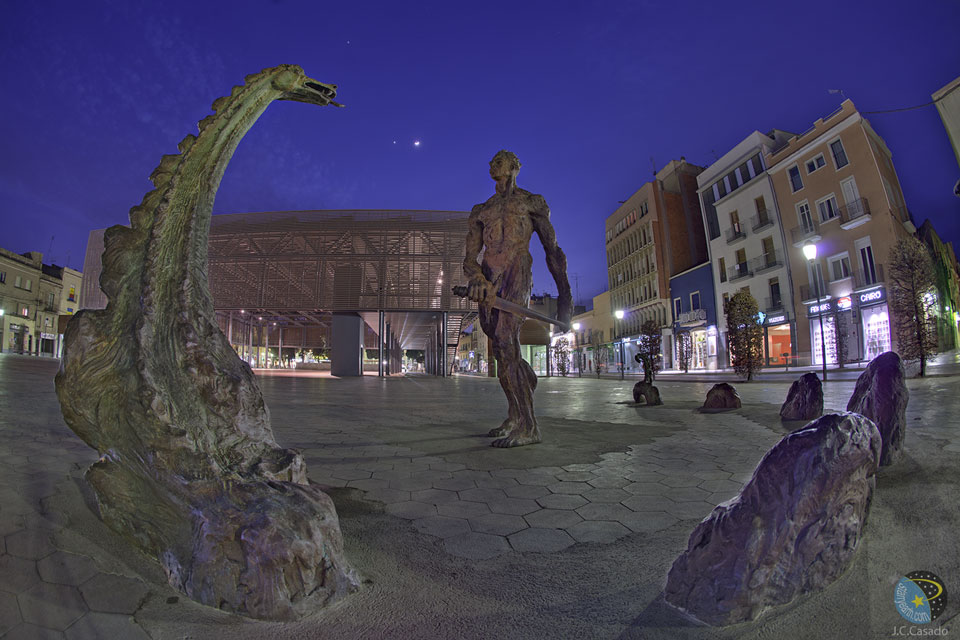 Moon and Planets Over Catalonia
Moon and Planets Over Catalonia
Image Credit & Copyright: Juan Carlos Casado (TWAN)
Explanation: Venus and Jupiter will appear unusually close in the sky over the next month. The
planetary conjunction will be easily visible to the unaided eye because Venus will appear brighter than any background star, and Jupiter will be nearly as bright. To see the near-alignment, simply look to the west after sunset. At their closest, on March 15, the two planets will appear only about three degrees apart. The planets will not be significantly closer in space - Venus will just be passing nearly in front of Jupiter as seen from the Earth. In the above image composite taken late last week from Catalonia, Spain, a bright crescent moon appears to the right of Venus, while Jupiter appears near the top of the image. The distant sun-illuminated spheres were photographed behind a sculpture depicting the legendary battle between a warrior and a dragon. A
gallery of conjunction images is visible on the Asterisk -- APOD's discussion board. Please feel free to contribute. The next
Jupiter-Venus conjunction will occur in May 2013.
2012 February 12
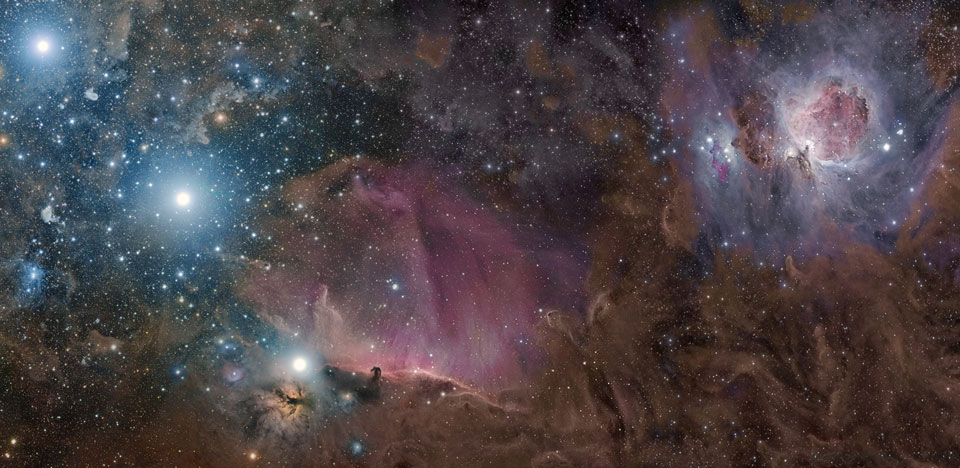 Orion in Gas, Dust, and Stars
Orion in Gas, Dust, and Stars
Image Credit & Copyright: Rogelio Bernal Andreo (Deep Sky Colors)Explanation: The constellation of Orion holds much more than three stars in a row. A deep exposure shows everything from dark nebula to star clusters, all embedded in an extended patch of gaseous wisps in the greaterOrion Molecular Cloud Complex. The brightest three stars on the far left are indeed the famous three starsthat make up the belt of Orion. Just below Alnitak, the lowest of the three belt stars, is the Flame Nebula, glowing with excited hydrogen gas and immersed in filaments of dark brown dust. Below the frame center and just to the right of Alnitak lies the Horsehead Nebula, a dark indentation of dense dust that has perhaps the most recognized nebular shapes on the sky. On the upper right lies M42, the Orion Nebula, an energetic caldron of tumultuous gas, visible to the unaided eye, that is giving birth to a new open cluster of stars. Immediately to the left of M42 is a prominent bluish reflection nebula sometimes called the Running Manthat houses many bright blue stars. The above image, a digitally stitched composite taken over several nights, covers an area with objects that are roughly 1,500 light years away and spans about 75 light years.
Starchild Ερώτηση του μήνα για τον Μάρτιο 2000
Ερώτηση:
Τι είναι το έτος φωτός και πώς χρησιμοποιείται;
Απάντηση:
Ένα έτος φωτός είναι μια μονάδα της απόστασης. Είναι η απόσταση που μπορεί να ταξιδέψει το φως σε ένα έτος. Φως κινείται με ταχύτητα περίπου 300.000 χιλιομέτρων (km) ανά δευτερόλεπτο. Έτσι, μέσα σε ένα χρόνο, μπορεί να ταξιδέψει περίπου 10 τρισεκατομμύρια χιλιόμετρα. Περισσότερα σ. recisely, ένα έτος φωτός ισούται με 9.500.000.000.000 χιλιόμετρα.
Γιατί θα θέλατε μια τέτοια μεγάλη μονάδα της απόστασης; Λοιπόν, στη Γη, ένα χιλιόμετρο μπορεί να είναι μια χαρά. Είναι λίγες εκατοντάδες χιλιόμετρα από τη Νέα Υόρκη στην Ουάσινγκτον, DC? Είναι μερικές χιλιάδες χιλιόμετρα από την Καλιφόρνια στο Μαίην. Στο σύμπαν, ο χιλιόμετρο είναι ακριβώς πάρα πολύ μικρή για να είναι χρήσιμες. Για παράδειγμα, η απόσταση μέχρι το επόμενο πλησιέστερο μεγάλο γαλαξία,ο γαλαξίας της Ανδρομέδας, είναι 21 τετράκις εκατομμύρια χιλιόμετρα. Αυτό είναι 21.000.000.000.000.000.000 χιλιόμετρα. Αυτό είναι ένας αριθμός τόσο μεγάλος ώστε να καθίσταται δύσκολο να γράψω και δύσκολο να ερμηνευθούν. Έτσι, οι αστρονόμοι χρησιμοποιούν άλλες μονάδες της απόστασης.
Σε μας ηλιακό σύστημα, έχουμε την τάση να περιγράφουν αποστάσεις όσον αφορά την αστρονομική μονάδα (AU). Η ΑΕ ορίζεται ως η μέση απόσταση μεταξύ της Γης και του Ήλιου. Είναι περίπου 150 εκατομμύρια χιλιόμετρα (93 εκατομμύρια μίλια). Ο υδράργυρος μπορεί να ειπωθεί για να είναι περίπου 1/3 των ΑΕ από τον Ήλιο και τον Πλούτωνα μέσο όρο περίπου 40 AU από τον Ήλιο. Η Αφρικανική Ένωση, ωστόσο, δεν είναι αρκετά μεγάλη από μια μονάδα, όταν αρχίσουμε να μιλάμε για τις αποστάσεις των αντικειμένων έξω από το ηλιακό μας σύστημα.
Για αποστάσεις σε άλλα μέρη του Γαλαξία μας (ή ακόμη περισσότερο), οι αστρονόμοι χρησιμοποιούν τις μονάδες του φωτός ή του χρόνου παρσέκ . Το έτος φωτός έχουμε ήδη καθοριστεί. Το παρσέκ είναι ίσο με το 3,3 έτη φωτός. Χρησιμοποιώντας το έτος φωτός, μπορούμε να πούμε ότι:
- Ο Καρκίνος σουπερνόβα υπόλοιπο είναι περίπου 4.000 έτη φωτός μακριά.
- Ο Γαλαξίας μας είναι περίπου 150.000 έτη φωτός.
- Ο γαλαξίας της Ανδρομέδας είναι 2,3 εκατομμύρια έτη φωτός μακριά.

